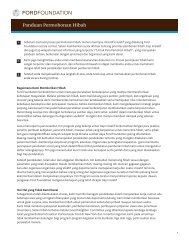Globalization, Health Sector Reform, Gender and ... - Ford Foundation
Globalization, Health Sector Reform, Gender and ... - Ford Foundation
Globalization, Health Sector Reform, Gender and ... - Ford Foundation
- No tags were found...
Create successful ePaper yourself
Turn your PDF publications into a flip-book with our unique Google optimized e-Paper software.
The “Targeting Women” Approach Failsto Address Society-Wide <strong>Gender</strong> InequalitiesMost sector programs “target” poor women to strengthen reproductivehealth <strong>and</strong> gender equity in health. However, the targetingapproach is partial <strong>and</strong> ineffective as a tool of gender-awarehealth strategy (Elson <strong>and</strong> Evers, 1998; Gilson, 1998). For instance,gender disaggregated indicators may show that most healthclinics do not have women doctors, so gender-specific policy componentsmay target expenditure for training more women doctors.However, without addressing the special problems womenface in finding the time <strong>and</strong>/or money to travel to <strong>and</strong> from aclinic—regardless of the presence of a female doctor—women’sneeds will not be adequately met. In a report for UNICEF,V<strong>and</strong>emoortele (2000) concludes that narrow targeting of servicesto the most needy is likely to yield savings that are “penny-wisebut pound-foolish.”The targeting approachshows little appreciationof the ways in whichgender inequalitieshave an impact on thecauses of poor healthamong the populationas a whole.By relying on better targeting, health sector reforms do not considerthe ways in which gendered norms pose particular difficultiesfor women providers <strong>and</strong> users—such as the problems facedby women doctors in re-locating to rural areas or women’s tendencyto undervalue their own health needs in comparison to thoseof their children <strong>and</strong> husb<strong>and</strong>s.Broadly speaking, targeting does not take into account the sectorwide<strong>and</strong> society-wide gender inequalities that influence women’sreproductive health status, women’s access to reproductive healthservices, <strong>and</strong> gender inequalities <strong>and</strong> gender bias in human resourcemanagement which have a strong bearing on the quality ofcare in reproductive health service delivery (see St<strong>and</strong>ing, H., 1997,1999, for a gender analysis of the human resource aspects of HSR).The targeting approach shows little appreciation of the ways inwhich gender inequalities among both providers <strong>and</strong> users of healthservices have an impact on the causes of poor health among thepopulation as whole. Some donors take these points on board.For instance, CIDA policy notes that “women are the main caregiversfor all the family; empowering girls <strong>and</strong> women throughcommunity development <strong>and</strong> access to education is the key tosocial <strong>and</strong> economic development, <strong>and</strong> the health of children, families<strong>and</strong> communities.” (CIDA, 1996, p.5, cited in Elson <strong>and</strong> Evers,1998). Yet the design of services <strong>and</strong> training which reflects thisunderst<strong>and</strong>ing tend to be absent from the implementation stage ofsector programs.26
















